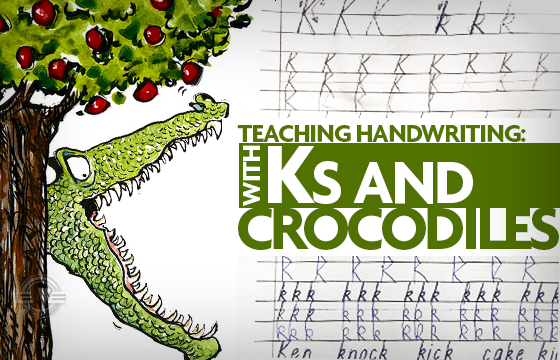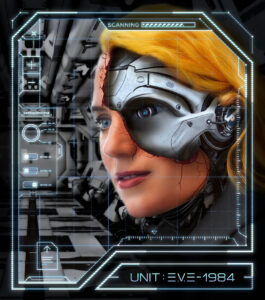Teaching Handwriting: Ks and Crocodiles

I hadn’t thought writing a K would be all that difficult. Perhaps I did think so, once upon a time, but I don’t remember it. Of all the letterforms in the English alphabet, I’d thought K was one of the easier ones.
Timmy disagreed.
Regardless of my teaching efforts, he continued to break their legs, littering K bones all over the page. Evidently, when looking at an uppercase K, he was just seeing three lines of varying directions—and the logic of his four-year-old mind said that the easiest way to draw that is from where they intersect. Despite demonstrations and repeated instructions (beginning in gentle tones and rapidly descending into madness) to make the second stroke a single movement that just bounces off the first, he continued to draw his K in three lines—the arms stemming off from the hub like bike spokes.
His finished Ks looked fine when he did them that way, but it defeated the point of his doing these lessons in the first place: the development of muscle memory in learning letterforms in a specific order (which is not alphabetical), in reference to their geometry, each new movement building on the previous—resulting in tidy, consistent penmanship at efficient speeds.
But nothing I said changed how he’d write a K. I was about to blow my stack. (I’m discovering that homeschooling has an uncanny ability to do this. It’s more character developing for me, than for him.)
“You’re not listening!” I found myself yelling. At the same time, my brain was screaming to me, This isn’t what you want to be, This isn’t how you want to teach, Stop Stop STOP!
But I didn’t know how to stop. I just saw a child refusing to follow instruction, refusing to be taught, refusing, refusing, refusing—
I clapped my hands over my eyes, which were already screwed shut. I took a deep breath. In the silence, I heard a tiny squeak in the back of Timmy’s throat. The paper of his worksheet made a whispering scrunch under his sweaty fingers.
“Timmy, we need to stop,” I said. Calmly. “I need a break, to settle down. We have to do this later.”
“No, I do a K!” Timmy cried. “I’m sorry, I’m sorry! I do a K!”
I felt awful. I felt like Miss Trunchbull.
I watched Timmy try his K again. The second stroke starting from the top, as I’d been trying to get him to do.
It didn’t work. The second stroke hugged the first, only mildly less vertical. It looked nothing like a K.
I suspect Timmy knew it. He gripped his pencil. He pressed his lips together. His eyes were wide. They didn’t blink.
I took a breath.
Again.
Again.
“Let me try something else,” I said. “I want to show you something.” I pulled another piece of paper toward me, and held my hand out for his pencil. He handed it over, warily.
“I’m going to tell you a story. This story has a tree in it,” I said, as I drew a tree. One of the cartoon types, with a top that looks like an equally-unrealistic cloud. I drew some apples in it, for theatrical embellishment. “See the tree?”
“Yeah, is a tree,” Timmy said. Then stabbing at it, “What’s that?”
“Those are apples.”
“Oh, apples.”
I decided next time perhaps I shouldn’t try to draw apples.
“But there’s something hiding behind the tree,” I said. “Can you guess what it is?”
“Um… What is it?” He tilted his head to one side, then to the other, as if to see around the pencilled tree.
He seemed to have forgotten all about the stress of drawing Ks. Even if this didn’t work, I’d take that part as a success.
“It’s a crocodile,” I said. “A crocodile with a big, wide, open mouth. He pokes his head out, from behind the tree…”
I added my crocodile, drawing his gaping maw in one stroke, from the top. Then I added his snout. Teeth. Eyes.
“Oh, yes, it’s a crocodile!” Timmy exclaimed, delighted. “He’s behind the tree!”
“Yup,” I said. “And look…” I darkened the line making the right-hand side of the tree trunk. I darkened the line of the crocodile’s mouth. “…It’s a K!”
A pause.
Then Timmy grinned. “Oh! Yeah! Is a K!”
“Let’s draw it,” I said. “We’ll draw a tree, and a crocodile.”
Timmy drew a vertical line. “There’s the tree,” he said.
“Looks good,” I said. Then held my breath.
“And…” Timmy moved his pencil up, “…here’s the crocodile…”
He draw a big gaping maw, top to bottom.
A perfect K.
Then another one. Then another one.
“Excellent!” I said, “What beautiful Ks!”
Timmy’s grin was so wide it just about sliced his face in half. And from that moment, writing Ks got a whole lot easier.
Even though the shape of the lowercase form was a lot more convoluted than the uppercase, I knew I had to translate it into a story — it seemed Timmy’s mind understood visual explanation, not geometric abstraction. The lowercase k then, we decided, was a butterfly behind the tree, showing his wing and his leg.
And so he drew it. A tree…a butterfly wing…and a leg. In one fluid movement. A beautiful lowercase k. In a tipsy still-learning-to-write kind of way.
That moment—the one where I found a way to enable him to understand something he couldn’t before—that was wonderful. That felt like teaching. It’s what I want to do again, and again, and again.
My Miss Trunchbull tendency still comes a lot more naturally. But we’re both still new at this. I don’t expect Timmy will be the only person learning things, during our homeschooling efforts.
Timmy learned how to write Ks.
I learned how to use a predatory reptile to my advantage. And I learned that Timmy’s a visual thinker.
He must be the son of a graphic designer.
(Header illustration compiled from drawings by Frits: hikingartist.com)


23 Oct 2016
It’s often easier to remember things that have a narrative flow to them, rather than undigested facts – or at least, I always find it so. And despite being visually oriented, I can’t draw for toffee (or any other form of bribe).
24 Oct 2016
Unfortunately for me, drawing is not in my current skill set either. (People tend to assume it is, imagining it’s part of graphic design, but they’re thinking of illustration, which a whole different discipline.)
I say ‘unfortunately’, because it’s exactly what Timmy wants me to do for him, all the time. I have to draw transport vehicles. Or animals. But not the easy way — I have to draw a specific animal, in a specific pose or activity. In sufficient detail. Ducks and lions are the most commonly requested. But if my duck looks too much like a goose, that’s not good enough and I have to try again.
24 Oct 2016
Ducks on Demand: the Unexpected Challenges of Parenting 🙂